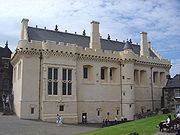
Harl
Encyclopedia

Scotland
Scotland is a country that is part of the United Kingdom. Occupying the northern third of the island of Great Britain, it shares a border with England to the south and is bounded by the North Sea to the east, the Atlantic Ocean to the north and west, and the North Channel and Irish Sea to the...
term describing an exterior building surfacing technique. The theory of harling is to produce a long-lasting weatherproof shield for a stone building. A pigment can be embedded in the harled material, thus obviating the need for repainting. Harling is a technique used to surface many Scottish castles, but it is also used for a variety of common everyday building types. It is long-lasting and practical and well suited to the Scottish weather.
Harling is a process of covering stonework, using a plaster
Plaster
Plaster is a building material used for coating walls and ceilings. Plaster starts as a dry powder similar to mortar or cement and like those materials it is mixed with water to form a paste which liberates heat and then hardens. Unlike mortar and cement, plaster remains quite soft after setting,...
ing process involving a slurry of small pebbles or fine chips of stone. After a wall is complete and has been pointed and allowed to cure then a base of lime render
Lime Render
Lime render is a lime-based cementitious mix applied to the external surfaces of traditionally-built stone buildings. It allows the building to 'breathe' - as lime is porous, it allows for the collection and evaporation of moisture...
is applied to the bare stone. While this render is still wet a specially shaped trowel is used to throw the pebbles onto the lime surface, which are then lightly pressed into it. Harl, being mostly lime render, cures chemically rather than simply drying. After this setting process the harl is sometimes lime washed
Whitewash
Whitewash, or calcimine, kalsomine, calsomine, or lime paint is a very low-cost type of paint made from slaked lime and chalk . Various other additives are also used...
in various colours using traditional techniques.
Cement
Cement
In the most general sense of the word, a cement is a binder, a substance that sets and hardens independently, and can bind other materials together. The word "cement" traces to the Romans, who used the term opus caementicium to describe masonry resembling modern concrete that was made from crushed...
base render cannot not be used in place of the lime, as it forms an impermeable barrier to moisture. The traditional harling process allows water to escape. This means that if cracking occurs the water is trapped behind the surface and often penetrates inside the softer stone, thus causing the rapid deterioration the technique is designed to prevent. For similar reasons modern barrier paints should not be used in place of traditional lime washes.
The technique of harling is utilised in a large number of famous Scottish buildings including Crathes Castle
Crathes Castle
Crathes Castle is a 16th century castle near Banchory in the Aberdeenshire region of Scotland. This harled castle was built by the Burnetts of Leys and was held in that family for almost 400 years...
, Craigievar Castle
Craigievar Castle
Craigievar Castle is a pinkish harled castle six miles south of Alford, Aberdeenshire, Scotland. It was the seat of Clan Sempill. The setting is among scenic rolling foothills of the Grampian Mountains...
, Muchalls Castle
Muchalls Castle
Muchalls Castle stands overlooking the North Sea in the countryside of Kincardine and Mearns, Aberdeenshire, Scotland. The lower course is a well preserved double groined 13th century towerhouse structure, built by the Frasers of Muchalls. Upon this structure, the 17th century castle was begun by...
, Myers Castle, and Stirling Castle
Stirling Castle
Stirling Castle, located in Stirling, is one of the largest and most important castles, both historically and architecturally, in Scotland. The castle sits atop Castle Hill, an intrusive crag, which forms part of the Stirling Sill geological formation. It is surrounded on three sides by steep...
.

